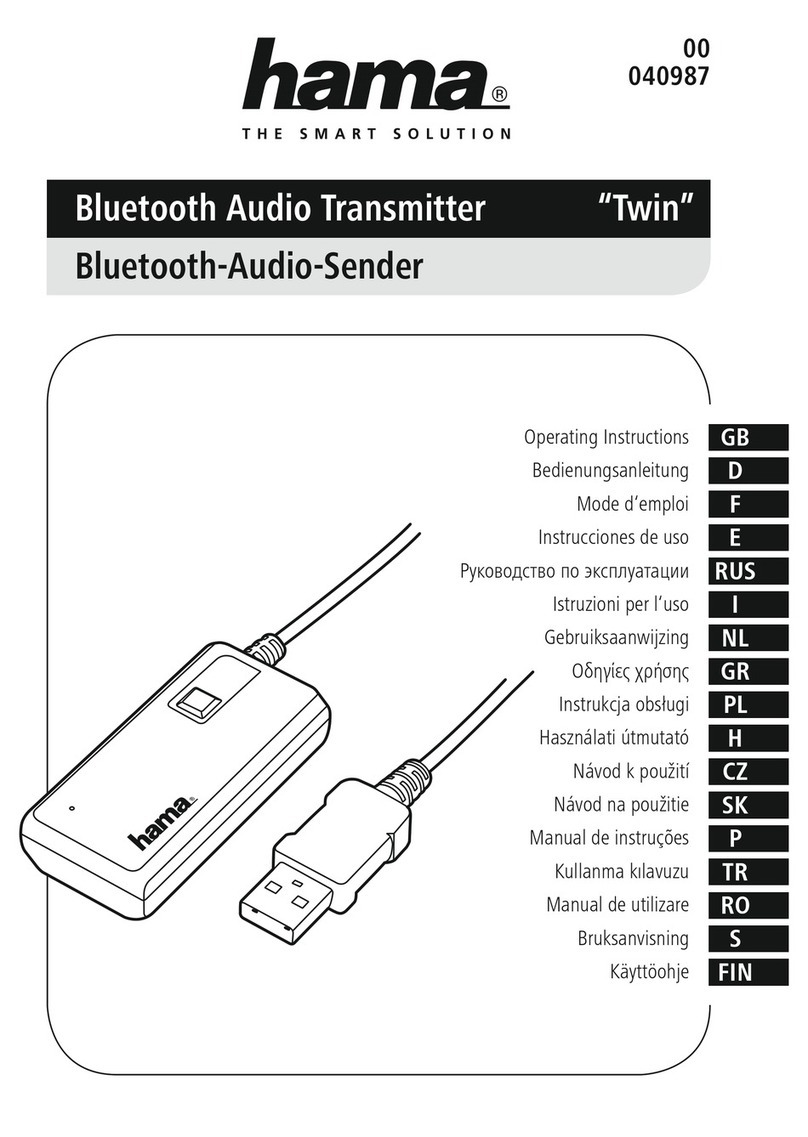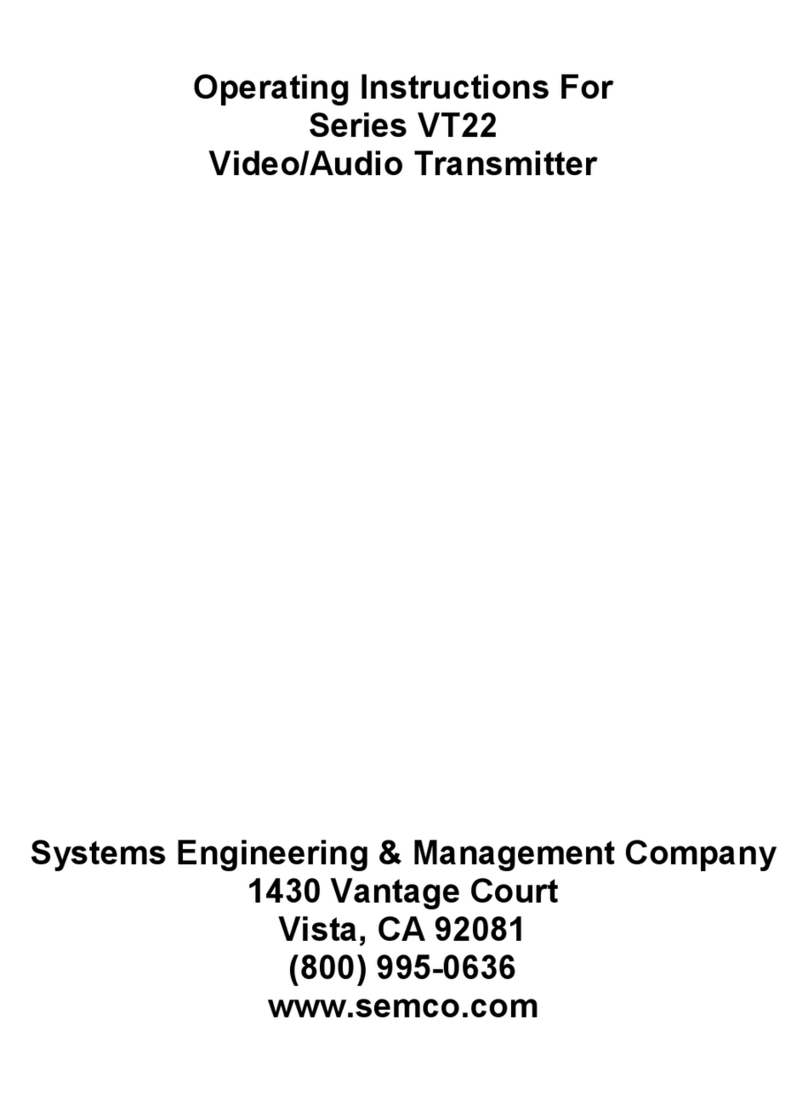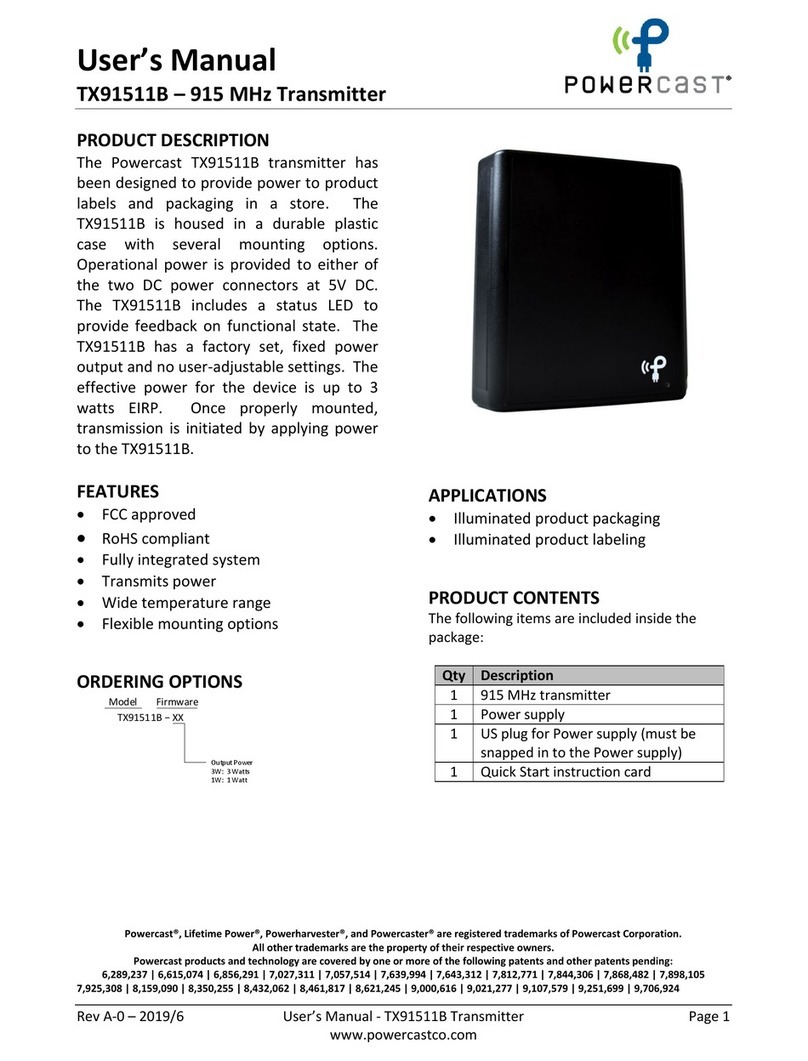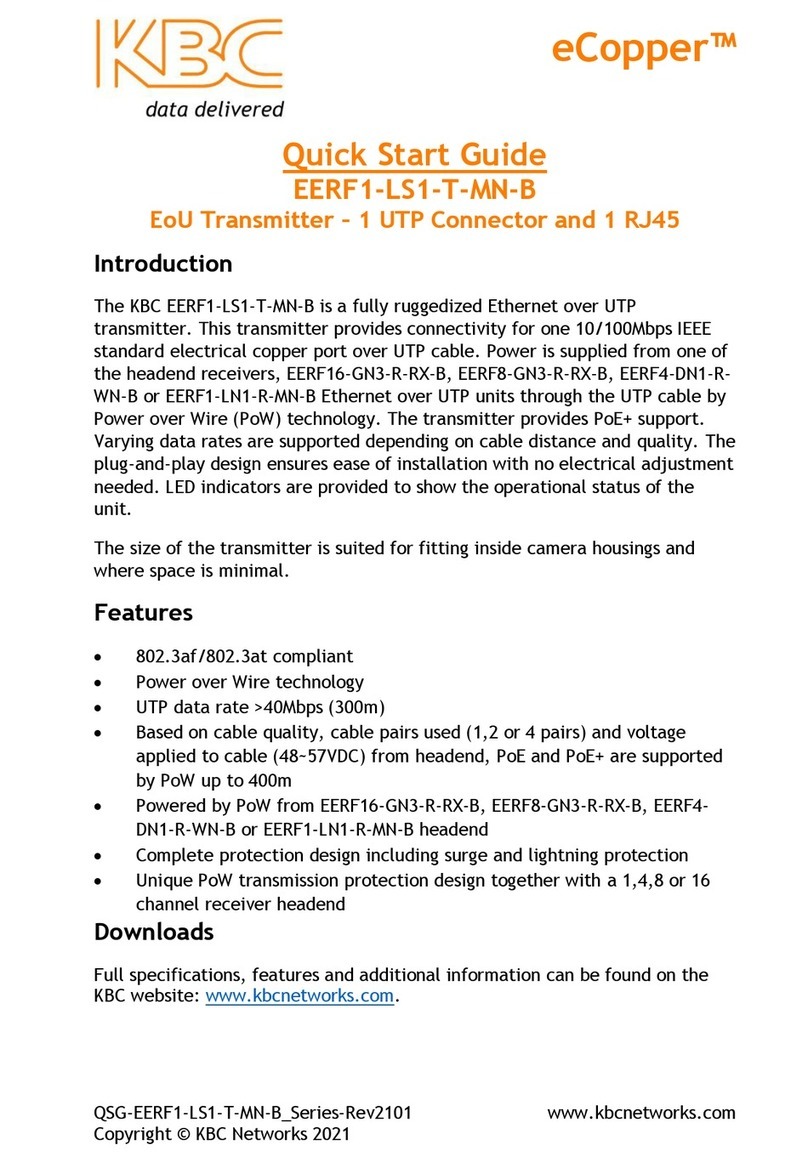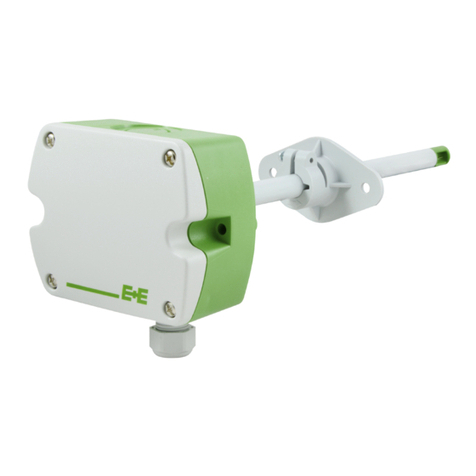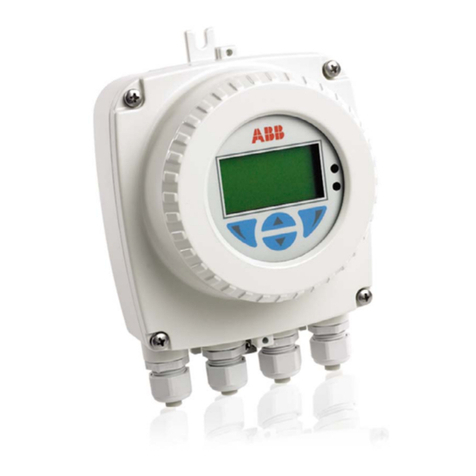Eclipse 706GWR User manual

Software Version 1.x
High Performance, 4th Generation
Guided Wave Radar
Level Transmitter
2014/68/EU

57-646 ECLIPSE Guided Wave Radar Transmitter - FOUNDATION fieldbus™
Read this Manua Before Insta ing
This manual provid s information on th Enhanc d
Eclips ®Mod l 706 GWR transmitt r with FOUNDATION
fi ldbus™ Output and should b us d in conjunction
with Eclips I&O manual 57-606. It is important that
all instructions ar r ad and follow d car fully.
Saf ty M ssag s
The ECLIPSE system is designed for use in Category II,
Pollution Degree 2 installations. Follow all standard
industry procedures for servicing electrical and computer
equipment when working with or around high voltage.
Always shut off the power supply before touching any
components. Although high voltage is not present in this
system, it may be present in other systems.
Electrical components are sensitive to electrostatic dis-
charge. To prevent equipment damage, observe safety
procedures when working with electrostatic sensitive
components.
This device complies with Part 15 of the FCC rules.
Operation is subject to the following two conditions
(1) This device may not cause harmful interference, and
(2) This device must accept any interference received,
including interference that may cause undesired operation.
WARNING! Explosion hazard. Do not connect or dis-
connect designs rated Explosion proof or Non-incendive
unless power has been switched off and/or the area is
known to be non-hazardous
Low Voltag Dir ctiv
For use in Installations Category II, Pollution Degree 2.
If equipment is used in a manner not specified by the
manufacturer, protection provided by equipment may be
impaired.
Notic of Copyright and Limitations
Copyright © 2017 Magnetrol International
All rights reserved
MAGNETROL & MAGNETROL logotype, and
ECLIPSE are registered trademarks of Magnetrol
International.
Performance specifications are effective with date of issue
and are subject to change without notice.
MAGNETROL reserves the right to make changes to the
product described in this manual at any time without
notice. MAGNETROL makes no warranty with respect
to the accuracy of the information in this manual.
Warranty
All MAGNETROL electronic level and flow controls are
warranted free of defects in materials or workmanship for
eighteen months from the date of original factory ship-
ment. If returned within the warranty period; and, upon
factory inspection of the control, the cause of the claim is
determined to be covered under the warranty; then,
MAGNETROL will repair or replace the control at no
cost to the purchaser (or owner) other than transportation.
MAGNETROL shall not be liable for misapplication,
labor claims, direct or consequential damage or expense
arising from the installation or use of equipment. There
are no other warranties expressed or implied, except spe-
cial written warranties covering some MAGNETROL
products.
Quality assuranc
The quality assurance system in place at MAGNETROL
guarantees the highest level of quality throughout the
company. Magnetrol is committed to providing full
customer satisfaction both in quality products and
quality service.
The MAGNETROL quality assurance
system is registered to ISO 9001
affirming its commitment to known
international quality standards
providing the strongest assurance of
product/service quality available.

Tab e of Contents
1.0 FOUNDATION fi ldbus™.................................................. 4
1.1 Overview...................................................................4
1.2 Device Description (DD)..........................................5
1.2.1 FOUNDATION fieldbus™ DD Revision Table....5
1.3 Link Active Scheduler (LAS).....................................5
1.4 Intrinsic Safety.......................................................... 6
2.0 Standard Function Blocks ..............................................7
2.1 Overview...................................................................7
2.1.1 Universal Fieldbus Block Parameters.............. 8
2.2 Resource Block (RB)................................................. 9
2.2.1 RB Parameters................................................9
2.2.2 Additional Resource Block Parameters......... 11
2.3 Transducer (TB)......................................................13
2.3.1 TB Parameters..............................................14
2.3.2 Password Protection..................................... 14
2.3.3 Model 706 FF Configuration Parameters..... 14
2.3.4 Model 706 FF Device-Specific
Configuration Parameters ............................15
2.4 Analog Input Block (AI)......................................... 15
2.4.1 AI Block Parameters..................................... 15
2.4.2 AI Block Diagnostics....................................18
2.4.3 Local Display of AI Block............................ 18
2.4.3.1 AI Out Display Screens......................... 19
2.4.4 AI Block Configuration................................20
2.4.5 Simulation Feature....................................... 21
2.5 PID Block...............................................................21
2.5.1 PID Block Parameters.................................. 21
3.0 Advanc d Function Blocks........................................... 24
3.1 Integrator Block (IT).............................................. 24
3.2 Arithmetic Block (AR)............................................ 26
3.3 Input Selector Block (ISEL).................................... 29
3.4 Signal Characterizer Block (SC).............................. 30
4.0 Mod l 706 Transmitt r Configuration.........................32
4.1 Configuration Information..................................... 32
4.2 Menu Transversal and Data Entry...........................33
4.2.1 Navigating the Menu................................... 33
4.2.2 Data Selection.............................................. 33
4.2.3 Entering Numeric Data Using Digit Entry.. 34
4.2.4 Entering Numerica Data Using
Increment/Decrement.................................. 34
4.2.5 Enter Character Data................................... 35
4.3 Password Protection................................................ 36
4.4 Model 706 Menu Step-By-Step Procedure............. 36
4.5 Model 706 Configuration Menu Device Setup...... 38
5.0 Troubl shooting and Diagnostics................................. 44
5.1 Diagnostic Parameters............................................. 44
5.1.1 Diagnostics (Namur NE 107)...................... 45
5.1.2 Diagnostic Indication Simulation.................47
5.1.3 Diagnostic Indicator Table........................... 47
5.1.4 Diagnostic Help........................................... 50
5.2 Diagnostic Parameters............................................. 51
5.3 FOUNDATION fieldbus Segment Checklist............... 54
6.0 R f r nc Information..................................................55
6.1 Agency Approvals....................................................55
6.2 Specifications.......................................................... 55
6.2.1 Agency Installation Drawing........................ 56
6.3 Model Number....................................................... 57
6.3.1 Transmitter...................................................57
6.3.2 Probes.......................................................... 58
6.4 Replacement Parts...................................................70
6.4.1 Replacement Parts........................................ 70
6.4.2 Recommended Spare Parts........................... 70
App ndix A......................................................................... 71
Eclips Mod l 706 GWR transmitt r
with FOUNDATION Fi ldbus™Output
57-646 ECLIPSE Guided Wave Radar Transmitter - FOUNDATION fieldbus™

4
1.0 FOUNDATION Fie dbus™
1.1 Overview
FOUNDATION fieldbus™is a digital communications system
that serially interconnects devices in the field. A Fieldbus
system is similar to a Distributed Control System (DCS)
with two exceptions
• Although a Foundation fieldbus™system can use the same
physical wiring as 4–20 mA device, Fieldbus devices are
not connected point to point, but rather are multidropped
and wired in parallel on a single pair of wires (referred to
as a segment).
• Foundation fieldbus™is a system that allows the user to
distribute control across a network. Fieldbus devices are
smart and can actually maintain control over the system.
Unlike 4–20 mA analog installations in which the two wires
carry a single variable (the varying 4–20 mA current), a dig-
ital communications scheme such as FOUNDATION field-
bus™considers the two wires as a network. The network can
carry many process variables as well as other information.
The ECLIPSE Model 706FF transmitter is a FOUNDA-
TION fieldbus™registered device that communicates with
the H1 FOUNDATION fieldbus™ protocol operating at
31.25 kbits/sec. The H1 physical layer is an approved IEC
61158 standard.
Details regarding cable specifications, grounding, termina-
tion, and other physical layer network information can be
found in IEC 61158 or the wiring installation application
guide AG-140 at www.fi ldbus.org.
57-646 ECLIPSE Guided Wave Radar Transmitter - FOUNDATION fieldbus™
Control Room
Power Supply
Terminator
6234 feet (1900 meters) maximum
PC
Terminator
Power
Conditioner

5
1.2 Device Description (DD)
A importa t requireme t of Fieldbus devices is the
co cept of i teroperability, defi ed as “the ability to operate
multiple devices i the same system, regardless of ma ufac-
turer, without loss of fu ctio ality.”
Device Descriptio (DD) tech ology is used to achieve this
i teroperability. The DD provides exte ded descriptio s
for each object a d provides perti e t i formatio eeded
by the host system. DDs are similar to the drivers that your
perso al computer (PC) uses to operate peripheral devices
co ected to it. A y Fieldbus host system ca operate with
a device if it has the proper DD a d Commo File Format
(CFF) for that device.
The most rece t DD a d CFF files ca be fou d o the
FOUNDATION fieldbus™web site at www.fieldbus.org or at
www.mag etrol.com.
NOTE: Consu t your host system vendor for any host-specific fi es that
may be needed.
1.3 Link Active Scheduler (LAS)
The default operati g class of the Eclipse Model 706FF
with FOUNDATION fieldbus™is a Basic device. However, it is
capable of bei g co figured as a Li k Active Scheduler
(LAS).
The LAS co trols all commu icatio o a FOUNDATION
fieldbus™segme t. It mai tai s the “Live List” of all devices
o a segme t a d coordi ates both the cyclic a d acyclic
timi g.
The primary LAS is usually mai tai ed i the host system,
but i the eve t of a failure, all associated co trol ca be
tra sferred to a backup LAS i a field device such as the
Eclipse®Model 706 FF.
NOTES:
1) The Ec ipse Mode 706 is norma y shipped from the factory with
Device C ass set to Basic.
2) The operating c ass can be changed from Basic to LAS using a
FOUNDATION fie dbus™configuration too .
57-646 ECLIPSE Guided Wave Radar Transmitter - FOUNDATION fie dbus™
Dev V2 DD V1 Apri 2017 Version 1.1a or ater

66
1.4 Intrinsic Safety
The H1 physical layer supports Intrinsic Safety (IS) applica-
tions with bus-powered devices. To accomplish this, an
Intrinsically Safe barrier or galvanic isolator is placed
between the power supply in the safe area and the device in
the hazardous area.
H1 also supports the Fieldbus Intrinsically Safe Concept
(FISCO) model which allows more field devices in a net-
work. The FISCO model considers the capacitance and
inductance of the wiring to be distributed along its entire
length. Therefore, the stored energy during a fault will be
less and more devices are permitted on a pair of wires.
Instead of the conservative entity model, which only allows
about 90 mA of current, the FISCO model allows a maxi-
mum of 110 mA for Class II C installations and 240 mA
for Class II B installations.
FISCO certifying agencies have limited the maximum seg-
ment length to 1000 meters because the FISCO model does
not rely on standardized ignition curves.
The ECLIPSE Model 706 FF is available with entity IS,
FISCO IS, FNICO non-incendive, or explosion proof
approvals.
57-646 ECLIPSE Guided Wave Radar Transmitter - FOUNDATION fieldbus™

7
2.0 Standard Function B ocks
2.1 Overview
The function of a FOUNDATION fieldbus™device is deter-
mined by the arrangement of a system of blocks defined by
the Fieldbus foundation. The types of blocks used in a typi-
cal User Application are described as either Standard or
Advanced.
Function Blocks are built into the FOUNDATION fieldbus™
devices as needed to provide the desired control system
behavior. The input and output parameters of function
blocks can be linked over the Fieldbus and there can be
numerous function blocks in a single User Application.
The Enhanced ECLIPSE Model 706FF is a Guided Wave
Radar (GWR) level transmitter with the following standard
FOUNDATION fieldbus™Function Blocks
• One (1) Resource Block (RB)
• Three (3) Custom Transducer Blocks (TB)
• Eight (8) Analog Input Function Blocks (AI)
• Two (2) PID Blocks (PID)
With Advanced Function Blocks
• One (1) Integrator Block (IT)
• One (1) Arithmetic Block (AR)
• One (1) Input Selector Block (IS)
• One (1) Signal Characterizer Block (SC)
The idea of Function Blocks, which a user can customize
for a particular application, is a key concept of Fieldbus
topology. Function Blocks consist of an algorithm, inputs
and outputs, and a user-defined name.
The Transducer Block (TB) output is available to the net-
work through the Analog Input (AI) blocks. Refer to
Section 2.3 for additional information on the Transducer
Blocks.
The AI blocks take the TB values and make them available
as an analog value to other function blocks. The AI blocks
have scaling conversion, filtering, and alarm functions.
Refer to Section 2.4 for additional information on the
Analog Input Blocks.
As shown in the diagram at left, the End User needs the
Process Variable value as an Analog Input to their fieldbus
network.
57-646 ECLIPSE Guided Wave Radar Transmitter - FOUNDATION fieldbus™
Model 706PVs
TB1 – Level
TB2 – Volume
TB3 – Flow & Totalizers
1
2
3
4
5
6
PV Status
Distance
PVStatus
Interface Level
PV Status
Upper Thickness
PVStatus
Echo Strength
PV Status
Ifc Echo strength
PVStatus
Electronics Temp.
PV Status
Probe Buildup
PV Status
Volume
PV Status
Flow
PV Status
Level
7
8
9
10
PV Status
Head
11
PV Status
NR Totalizer
12
PV Status
R Totalizer
13
Diagnostic Indicators
Diagnostic Indicators
Diagnostic Indicators
NE 107
CF
Process
Data
NE 107
Failure
NE 107
MR
NE 107
Spec
Diagram
Mapping
RB
AI 1
AI 2
AI 3
Integrator
PID1
AI 4
AI 5
AI 6
AI 7
AI 8
Note: Number next to PV refersto
channelnumberintheAIBlocks.

857-646 ECLIPSE Guided Wave Radar Transmitter - FOUNDATION fieldbus™
The following are general descriptions of the parameters
common to all function blocks. Additional information for
a given parameter may be described later in a section that
describes the specific block.
ST_REV a read only parameter that gives the revision level
of the static data associated with the block. This parameter
will be incremented each time a static parameter attribute
value is written and is a vehicle for tracking changes in static
parameter attributes.
TAG_DESC a user assigned parameter that describes the
intended application of any given block.
STRATEGY: a user assigned parameter that identifies
groupings of blocks associated with a given network connec-
tion or control scheme.
ALERT_KEY a user assigned parameter which may be used
in sorting alarms or events generated by a block.
MODE_BLK a structured parameter composed of the
actual mode, the target mode, the permitted mode(s), and
the normal mode of operation of a block.
• Target The mode to “go to”
• Actual The mode the “block is currently in”
• Permitted Allowed modes that target may take on
• Normal Most common mode for target
NOTES:
1) It may be required to hange the the MODE_BLK target parame-
ter to OOS (out of servi e) to hange onfiguration parameters in
that spe ifi fun tion blo k. (When in OOS, the normal algorithm
is no longer exe uted and any outstanding alarms are leared.)
2) All blo ks must be in an operating mode for the devi e to oper-
ate. This requires the Resour e Blo k and the Transdu er Blo k
to be in “AUTO” before the spe ifi fun tion blo k an be pla ed
in a mode other than OOS (out of servi e).
BLOCK_ERR: a parameter that reflects the error status of
hardware or software components associated with, and
directly affecting, the correct operation of a block.
NOTE: A BLOCK_ERR of “Simulation A tive” in the Resour e Blo k
does not mean simulation is a tive—it merely indi ates that the
simulation (hardware) enabling jumper is present and soft sim-
ulation disable is set to NO. (See page 13 and refer to Se tion
2.4.5 for additional information).

9
57-646 ECLIPSE Guided Wave Radar Transmitter - FOUNDATION fieldbus™
2.2 Resource B ock
The RESOURCE BLOCK describes the characteristics of
the FOUNDATION fieldbus™device such as the device name,
manufacturer, and serial number. As it only contains data
specific to the Eclipse Model 706 FF transmitter, it has no
control function.
MODE_BLK Must be in AUTO in order for the remain-
ing function blocks in the transmitter to operate.
NOTE: A Resour e Blo k in “out of servi e” mode will stop all fun tion
blo k exe ution in the transmitter.
RS_STATE Identifies the state of the RESOURCE block
state machine. Under normal operating conditions, it
should be “On-Line.”
DD_RESOURCE A string identifying the tag of the
resource that contains the Device Description for this
device.
MANUFAC_ID Contains Magnetrol International’s
FOUNDATION fieldbus™manufacturer’s ID number, which is
0x000156.
DEV_TYPE The model number of the ECLIPSE Model
706 FF transmitter (0x0005). It is used by the Host System
and other fieldbus interface devices to locate the Device
Descriptor (DD) file.
DEV_REV Contains the firmware revision of the
ECLIPSE Model 706 FF transmitter and is used by the
Host System and other fieldbus interface devices to correctly
select the associated DD.
DD_REV Contains the revision of the DD associated with
the version of firmware in the ECLIPSE Model 706 FF
transmitter. It is used by the Host System and other
Fieldbus interface devices to correctly select the associated
DD.
RESTART Default and Processor are the available selec-
tions. Default will reset the Model 706 to the default
factory block configuration.
NOTE: As RESTART DEFAULT will set most fun tion blo k onfigura-
tion parameters to their default values. Devi es need to be
re onfigured following a tivation of this fun tion.
FEATURES A list of the features available in the transmit-
ter, such as Reports and Soft Write Lock.
FEATURES_SEL Allows the user to turn Features on or
off.

10 57-646 ECLIPSE Guided Wave Radar Transmitter - FOUNDATION fieldbus™
CYCLE_TYPE Identifies the block execution methods that
are available.
CYCLE_SEL Allows the user to select the block execution
method.
MIN_CYCLE_T The time duration of the shortest cycle
interval. It puts a lower limit on the scheduling of the
resource.
NV_CYCLE_T The minimum time interval between
copies of non-volatile (NV) parameters to NV memory. NV
memory is only updated if there has been a significant
change in the dynamic value and the last value saved will be
available for the restart procedure.
NOTE: After ompleting a download, allow several se onds before
removing power from the ECLIPSE Model 706 FF transmitter to
ensure that all data has been saved.
FREE_SPACE Shows the amount of available memory for
further configuration. The value is zero percent in a precon-
figured device.
FREE_TIME The amount of the block processing time
that is free to process additional blocks.
SHED_RCAS The time duration at which to give up com-
puter writes to function block RCas locations.
SHED_ROUT The time duration at which to give up
computer writes to function block ROut locations.
FAULT_STATE, SET_FSTATE, CLR_FSTATE These
only apply to output function blocks. (The Model 706FF
has no output function blocks).
MAX_NOTIFY The maximum number of alert reports
that the transmitter can send without getting a confirma-
tion.
LIM_NOTIFY the maximum numbers of unconfirmed
alert notify messages allowed. No alerts are reported if set to
zero.
CONFIRM_TIME the time that the transmitter will wait
for confirmation of receipt of a report before trying again.
Retry will not occur if CONFIRM_TIME = 0.
WRITE_LOCK When set to LOCKED, will prevent any
external change to the static or non-volatile data base in the
Function Block Application of the transmitter. Block con-
nections and calculation results will proceed normally, but
the configuration will be locked.
UPDATE_EVT (Updat Ev nt) Is an alert generated by a
write to the static data in the block.

11
57-646 ECLIPSE Guided Wave Radar Transmitter - FOUNDATION fieldbus™
BLOCK_ALM (Block Alarm) Is used for configuration,
hardware, connection, or system problems in the block. The
cause of any specific alert is entered in the subcode field.
ALARM_SUM (Alarm Summary) Contains the current
alert status, the unacknowledged states, the unreported
states, and the disabled states of the alarms associated with
the block.
ACK_OPTION (Acknowl dg Option) Selects whether
alarms associated with the block will be automatically
acknowledged.
WRITE_PRI (Writ Priority) The priority of the alarm
generated by clearing the write lock.
WRITE ALM (Writ Alarm) The alert generated if the
write lock parameter is cleared.
ITK_VER (ITK V rsion) Contains the version of the
Interoperability Test Kit (ITK) used by the Fieldbus
Foundation during their interoperability testing.
COMPATIBILITY_REV This parameter is intended to
assist users and host system in device replacement scenarios.
It is a read-only parameter and the value of the
COMPATIBILITY_REV is defined by the device developer
and manufacturer. In such device replacement scenario the
DEV_REV value of the replaced device is equal or greater
than the COMPATIBILITY_REV value of the new device.
Additional parameters are available within the resource
block for use with NE-107 to aid in communicating device
conditions to the user.
FD_VER Major version of the Field Diagnostic specifica-
tion to which this device conforms.
FD_FAIL_ACTIVE For error conditions that have been
selected for the FAIL alarm category, this parameter reflects
those that have been detected as active.
FD_OFFSPEC_ACTIVE For error conditions that have
been selected for the OFFSPEC alarm category, this para-
meter reflects those that have been detected as active.
FD_MAINT_ACTIVE For error conditions that have been
selected for the MAINT alarm category, this parameter
reflects those that have been detected as active.
FD_CHECK_ACTIVE For error conditions that have
been selected for the CHECK alarm category, this parame-
ter reflects those that have been detected as active.
FD_FAIL_MAP Maps conditions to be detected as active
for the FAIL alarm category.

12
FD_OFFSPEC_MAP Maps conditions to be detected as
active for the OFFSPEC alarm category.
FD_MAINT_MAP Maps conditions to be detected as
active for the MAINT alarm category.
FD_CHECK_MAP Maps conditions to be detected as
active for the CHECK alarm category.
FD_FAIL_MASK Used to suppress an alarm from being
broadcast for single or multiple conditions that are active in
the FAIL alarm category.
FD_OFFSPEC_MASK Used to suppress an alarm from
being broadcast for single or multiple conditions that are
active in the OFFSPEC alarm category.
FD_MAINT_MASK Used to suppress an alarm from
being broadcast for single or multiple conditions that are
active in the MAINT alarm category.
FD_CHECK_MASK Used to suppress an alarm from
being broadcast for single or multiple conditions that are
active in the CHECK alarm category.
FD_FAIL_ALM Used to broadcast a change in the associ-
ated active conditions, which are not masked, for the FAIL
alarm category.
FD_OFFSPEC_ALM Used to broadcast a change in the
associated active conditions, which are not masked, for the
OFFSPEC alarm category.
FD_MAINT_ALM Used to broadcast a change in the
associated active conditions, which are not masked, for the
MAINT alarm category.
FD_CHECK_ALM Used to broadcast a change in the
associated active conditions, which are not masked, for the
CHECK alarm category.
FD_FAIL_PRI Specifies the priority of the FAIL alarm
category.
FD_OFFSPEC_PRI Specifies the priority of the OFF-
SPEC alarm category.
FD_MAINT_PRI Specifies the priority of the MAINT
alarm category.
FD_CHECK_PRI Specifies the priority of the CHECK
alarm category.
FD_SIMULATE Diagnostic conditions can be manually
supplied when simulation is enabled.
FD_RECOMMEN_ACT Describes what actions can be
taken to address an active diagnostic condition.
57-646 E lipse Guided Wave Radar Transmitter - FOUNDATION fieldbus

13
FD_EXTENDED_ACTIVE_1 For error conditions that
have been selected in the Extended_Map_1 parameter, this
parameter reflects those that have been detected as active.
FD_EXTENDED_MAP_1 Allows the user finer control
in selecting multiple conditions contributing to a single
condition that may be mapped for the various alarm cate-
gories.
Manufacturer-Specific Parameters:
SOFT_SIMULATION_DISABLE If set to yes, enabling
of simulation is disallowed regardless of the presence of the
simulation jumper, and the “simulation” indicator will be
cleared in the Block Error parameter. If set to no, simula-
tion can only be enabled if the simulation jumper is present
which also sets the “simulation” indicator in the Block Error
parameter.
SERIAL_NUMBER Read-only parameter that corresponds
to “Magnetrol Serial Number” in the Transducer Block.
FIRMWARE_VERSION Read-only parameter that corre-
sponds to “Firmware Version” in the Transducer Block.
HARDWARE_VERSION Read-only parameter that corre-
sponds to “Hardware Version” in the Transducer Block.
2.3 Transducer B ock
The three TRANSDUCER blocks (TB) contained within
the ECLIPSE Model 706 FF transmitter are custom blocks
containing parameters that are pertinent to the transmitter
itself.
TRANSDUCER Block 1 (used for level and interface oper-
ation) contains information such as the Configuration,
Diagnostics, Calibration data, output level and Status infor-
mation.
TRANSDUCER Blocks 2 and 3 contain volume and flow
parameters respectively.
The read-only parameters and read-write parameters within
the TB are grouped in a useful configuration.
• The read-only parameters report the block status and
operation modes.
• The read-write parameters affect both the operation of
the function block and the transmitter itself.
NOTE: The Transdu er Blo k will automati ally be hanged to “Out of
Servi e” when the lo al interfa e (keypad) is used to hange a
stati parameter online. The Transdu er Blo k must be manually
pla ed ba k in servi e from the Host System to resume
operation.
57-646 ECLIPSE Guided Wave Radar Transmitter - FOUNDATION fieldbus™

14
The first six parameters in the TRANSDUCER Block are the
universal parameters discussed in section 4.1.1. After the
universal parameters, six additional parameters are required
for Transducer Blocks. The most notable of these parame-
ters are UPDATE_EVT and BLOCK_ALM. It should be
noted that these six additional parameters must exist but do
not have to be implemented.
An important device-specific parameter found later in the
TRANSDUCER Block list is DEVICE_STATUS, which
displays the status of the device. If more than one message
exists, then the messages are displayed in priority order.
If DEVICE_STATUS indicates a problem, refer to
Section 5.2, Troubleshooting.
NOTE: The user should ompare the DD file and revision number of the
devi e with the HOST system to ensure they are at the same
revision level.
Please refer to the DD Revision Table Section 1.2.1.
Please refer to Appendix A for a complete list of the three
Transducer Block parameter sets.
To change a parameter at the local user interface, a value
matching the user password must be entered (Default = 1).
If a static parameter is changed from the local user interface,
the Associated Transducer Block goes Out of Service
(OOS).
Please refer to the Section 4.3 for additional information
regarding passwords.
After 5 minutes with no keypad activity, the entered pass-
word expires. However, the device must be placed back in
service from the Host System.
From the Host system network, the instrument always
behaves as if it is in the user password mode by default. In
other words, it is not necessary to enter the user password in
order to write most parameters from the Host system.
One of the main advantages of the Eclipse Model 706 FF
GWR transmitter is that the device can be delivered pre-
configured to the user.
57-646 ECLIPSE Guided Wave Radar Transmitter - FOUNDATION fieldbus™

15
57-646 ECLIPSE Guided Wave Radar Transmitter - FOUNDATION fieldbus™
On the other hand, part of the advantage of FOUNDATION
fieldbus™ is to provide the ability to monitor changes and
make adjustments to a transmitter. The Fieldbus™ concept
allows a user to make adjustments if deemed necessary.
Please refer to ECLIPSE Model 706 I/O Manual 57-606
for detailed information on the Model 706 device-specific
configuration parameters.
2.4 Ana og Input B ock
The ANALOG INPUT (AI) block takes the ECLIPSE
Model 706 FF input data, selected by channel number, and
makes it available to other function blocks at its output.
The channel selections are
The following are general descriptions of the parameters
common to all function blocks. Additional information for
a given parameter may be described later in a section that
describes the specific block.
Transducer
Blocks Process Variable
Channel Parame er
Value
(AI Blocks)
TB1 – Level
Level 1
Interface Level 2
Upper Thickness 3
Distance 4
Echo Strength 5
Ifc Echo Strength 6
Electronics Temperature 7
Probe Buildup 8
TB2 – olume olume 9
TB3 – Flow
and Totalizers
Flow 10
Head 11
NR Totalizer 12
R Totalizer 13

16 57-646 ECLIPSE Guided Wave Radar Transmitter - FOUNDATION fieldbus™
ST_REV a read only parameter that gives the revision level
of the static data associated with the block. This parameter
will be incremented each time a static parameter attribute
value is written and is a vehicle for tracking changes in static
parameter attributes.
TAG_DESC a user assigned parameter that describes the
intended application of any given block.
STRATEGY: a user assigned parameter that identifies
groupings of blocks associated with a given network connec-
tion or control scheme.
ALERT_KEY a user assigned parameter which may be used
in sorting alarms or events generated by a block.
MODE_BLK a structured parameter composed of the
actual mode, the target mode, the permitted mode(s), and
the normal mode of operation of a block.
• Target The mode to “go to”
• Actual The mode the “block is currently in”
• Permitted Allowed modes that target may take on
• Normal Most common mode for target
PV Either the primary analog value for use in executing the
function, or a process value associated with it.
OUT The primary analog value calculated as a result of
executing the function block.
SIMULATE Allows the transducer analog input or output
to the block to be manually supplied when simulate is
enabled. When simulate is disabled, the simulate value and
status track the actual value and status. Please refer to
Section 2.4.5 for additional information.
XD_SCALE The high and low scale values, Engineering
Units, and number of digits to the right of the decimal
point used with the value obtained from the transducer for
a specified channel.
OUT_SCALE The high and low scale values, Engineering
Units, and number of digits to the right of the decimal
point to be used in displaying the OUT parameter.
GRANT_DENY Options for controlling access of host
computers and local control panels to operating, tuning,
and alarm parameters of the block.
IO_OPTS Option which the user may select to alter input
and output block processing.
STATUS_OPTS Options which the user may select in the
block processing of status.

17
57-646 ECLIPSE Guided Wave Radar Transmitter - FOUNDATION fieldbus™
CHANNEL The number of the logical hardware channel
that is connected to this I/O block. (This information
defines the transducer to be used going to or from the phys-
ical world).
L_TYPE Determines if the values passed by the transducer
block to the AI block may be used directly (Direct), or if
the value is in different units and must be converted linearly
(Indirect), using the input range defined for the transducer
and the associated output range.
LOW_CUT Limit used in square root processing.
PV_FTIME Time constant of a single exponential filter for
the PV, in seconds.
FIELD_VAL Raw value of the field device in % of PV
range, with a status reflecting the Transducer condition
before signal characterization (L_TYPE) or filtering
(PV_FTIME).
UPDATE_EVT This alert is generated by any change to
the static data.
BLOCK_ALM The block alarm is used for all configura-
tion, hardware, or system problems in the block.
ALARM_SUM The current alert status, unacknowledged
states, unreported states, and disabled states of the alarms
associated with the function block.
ACK_OPTION Selection of whether alarms associated
with the function block will be automatically acknowledged.
ALARM_HYS Amount the PV must return within the
alarm limits before the alarm condition clears. Alarm hys-
teresis expressed as a percent of the span of the PV.
HI_HI_PRI Priority of the high high alarm.
HI_HI_LIM The setting for high high alarm in engineer-
ing units.
HI_PRI Priority of the high alarm.
HI_LIM The setting for high alarm in engineering units
LO_PRI Priority of the low alarm.
LO_LIM The setting for low alarm in engineering units.
LO_LO_PRI Priority of the low low alarm.
LO_LO_LIM The setting for low low alarm in engineering
units.
HI_HI_ALM The status for high high alarm and its associ-
ated time stamp.
HI_ALM Status for high alarm and associated time stamp.
LO_ALM Status for low alarm and associated time stamp.

18 57-646 ECLIPSE Guided Wave Radar Transmitter - FOUNDATION fieldbus™
LO_LO_ALM The status for low low alarm and its associ-
ated time stamp.
BLOCK_ERR_DESC Reports more specific details regard-
ing some errors reported through BLOCK_ERR.
The MODE_BLK parameter (within both the TB and AI
Blocks) must be set to AUTO to pass the PV Value through
the AI to the network.
Transducer scaling, called XD_SCALE is applied to the PV
from the CHANNEL to produce the FIELD_VAL in per-
cent.
• Valid XD_SCALE engineering units depend on the
Channel Type.
The AI blocks can display a BLOCK_ERR diagnostic
when
1. The Channel is not set correctly. (Refer to Default Channel
Table in Section 2.4).
2. XD_SCALE does not have suitable engineering units
3. The SIMULATE parameter is active.
4. AI block MODE is O/S (out of service).
NOTE: This an be aused by the Resour e Blo k being OOS or the AI
Blo k not s heduled for exe ution.
5. L-TYPE not set or set to Direct with improper
OUT_SCALE.
The AI block uses the STATUS_OPTS setting and the
TRANSDUCER PV LIMIT value to modify the AI PV
and OUT QUALITY.
A Damping Filter is a feature of the AI block. The
PV_FTIME parameter is a time constant of a single expo-
nential filter for the PV, in seconds. This parameter can be
used to dampen out fluctuation in level due to excessive tur-
bulence.
The AI block also has multiple ALARM functions that
monitor the OUT parameter for out of bound conditions.
The ECLIPSE Model 706FF transmitter incorporates a use-
ful feature that allows the Analog Input (AI) block Out val-
ues to be displayed on the local LCD.

19
57-646 ECLIPSE Guided Wave Radar Transmitter - FOUNDATION fieldbus™
NOTE: There are many reasons that AI blo k Out values an deviate
from the measurement value originating in the Transdu er
blo k, and be ause the keypad and lo al display will only pro-
vide a ess to Transdu er blo k parameters, there is no way to
hange (or view) the other fieldbus onfiguration items affe ting
the AI blo k output using the keypad and LCD.
In other words, these screens should only be considered as
measured value indicators for configured transmitters. For
example
• The screens are not used for commissioning or diagnos-
tic/troubleshooting purposes.
• Prior to full fieldbus configuration (transmitter assigned a
permanent address, AI block(s) configured and scheduled
for execution, etc.), the value displayed will not reflect the
transducer measurement.
2.4.3.1 AI Out Display Screens
The Analog Input Block Out values can be conditionally
displayed as part of the “rotating” home menu screens. A
representative example is shown at left.
The screens will be formatted as shown with
• Physical Device Tag (Selectable)
• Measured Value Status (Bad, Good, Uncertain)
• Bar Graph
For example, “AI1_Level” would be the most commonly
used AI Out screen.
“AI2---” would be displayed when the channel value is 0
[uninitialized] for AI block 2.
Because the Model 706 transmitter has eight (8) Analog
Input blocks, any or all of which may be used in particular
applications, a Transducer block parameter controls which
AI block Out values will be displayed on the LCD.
Any or all (or none) of the AI block Out values can be
selected for display on the LCD.
NOTE: In the photo at left, status is shown as “Bad out of Servi e”.
This message would be shown prior to ommissioning.

20 57-646 ECLIPSE Guided Wave Radar Transmitter - FOUNDATION fieldbus™
Below are shown some examples of various typical AI Block
configurations.
Probe
PL [in / cm]
Probe Length = PL Inchesorcm
Transducer
Block +
LCD Level
AI Block Output
[To FF s egment]
100%
0 [in/cm] 0%
Probe
Probe Length
111 cm
81.3 cm
0 cm
100%
0%
Offset = –15.5 cm
Transducer
Block+
LCD Level
AI Block Output
[To FF segment]
Configura ion
Probe Length 111
Level Offset -15.5
XD Scale EU at 0% 0
XD Scale EU at 100% 81.3
XD Scale Units cm
Out Scale EU at 0% 0
Out Scale EU at 100% 100
Out Scale Units %
L Type Indirect
Configura ion
Probe Length 111
Level Offset -15.5
XD Scale EU at 0% 0
XD Scale EU at 100% 81.3
XD Scale Units cm
Out Scale EU at 0% 0
Out Scale EU at 100% 81.3
Out Scale Units cm
L Type Direct
Probe
Probe Length
111 cm
81.3 cm
0 cm
81.3 cm
0 cm
Offset = –15.5 cm
Transducer
Block +
LCDLevel
AI Block Output
[To FF segment]
Configura ion
Probe Length PL
Level Offset 0
XD Scale EU at 0% 0
XD Scale EU at 100% PL
XD Scale Units in/cm
Out Scale EU at 0% 0
Out Scale EU at 100% 100
Out Scale Units %
L Type Indirect
Example 1: standard
configuration for trans-
mitter with probe of
length PL inches or cm.
[setup by factory as
part of final assembly
procedure]
Example 2: end user desires 0 to
100% output for a subset of the
measureable region [probe]
[e.g., for a chamber application]
Example 3: same configuration as
previous except Direct [no] scaling
setup in AI block
Output to FF segment is in cm
Table of contents
Other Eclipse Transmitter manuals
Popular Transmitter manuals by other brands
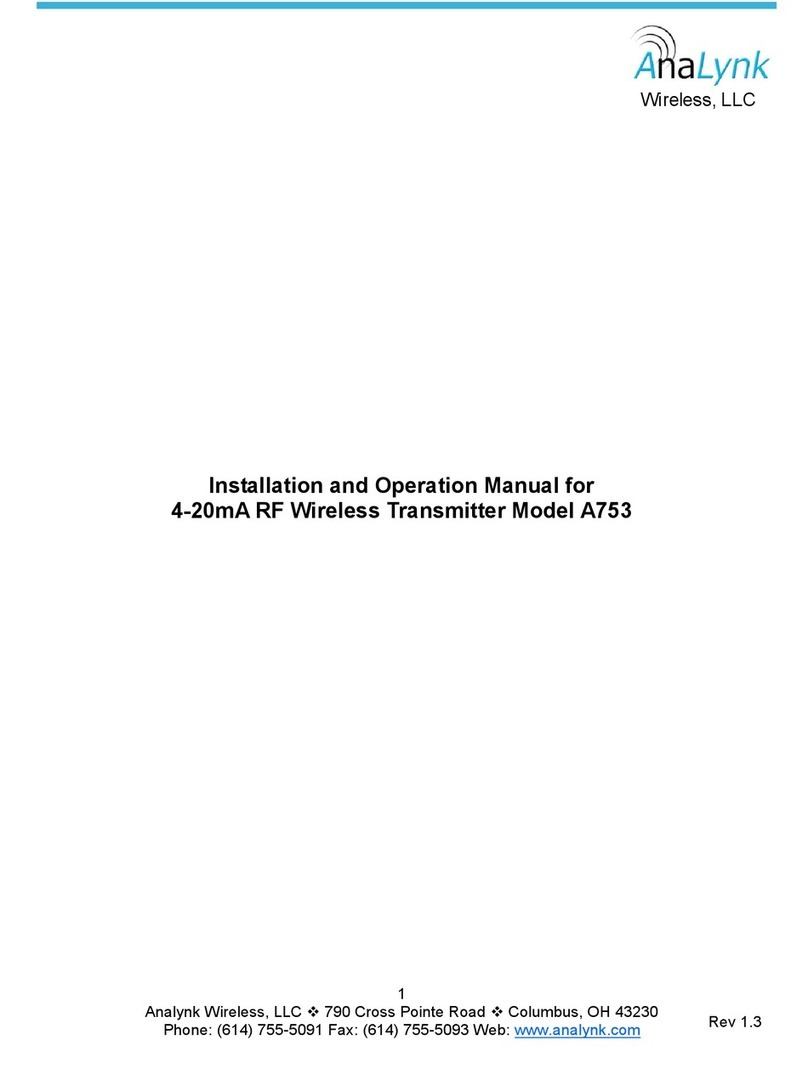
AnaLynk
AnaLynk A753 Installation and operation manual
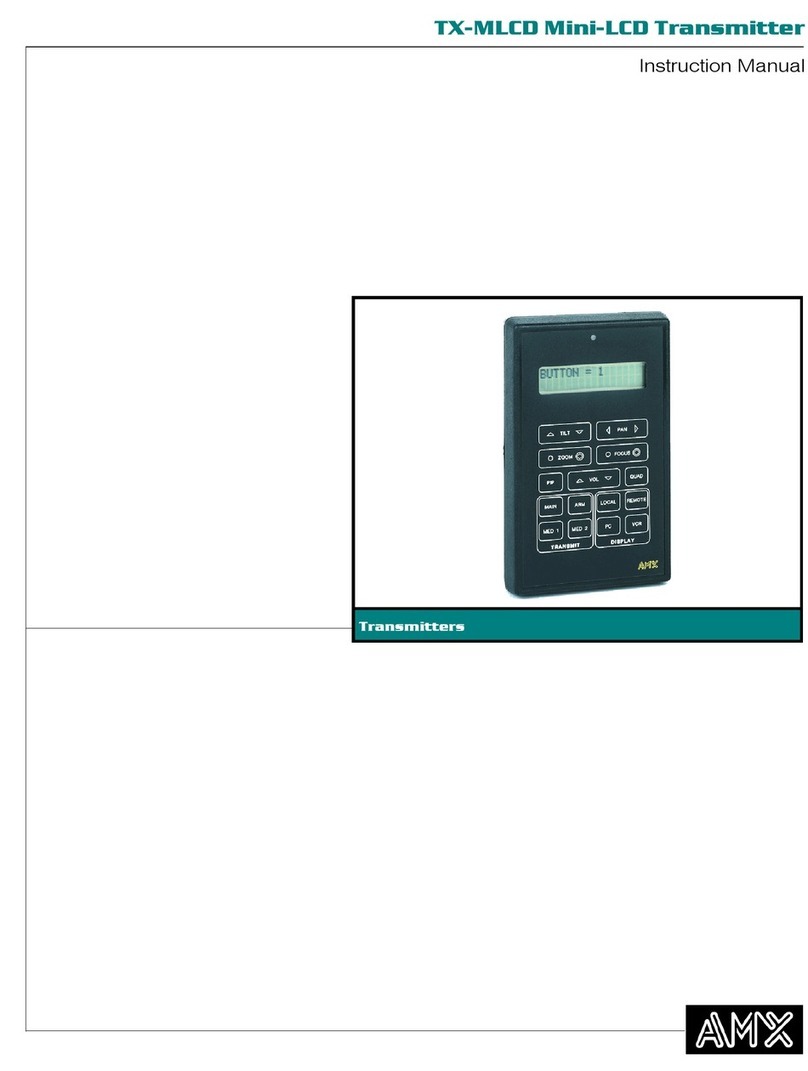
AMX
AMX Mini-LCD Transmitter TX-MLCD instruction manual
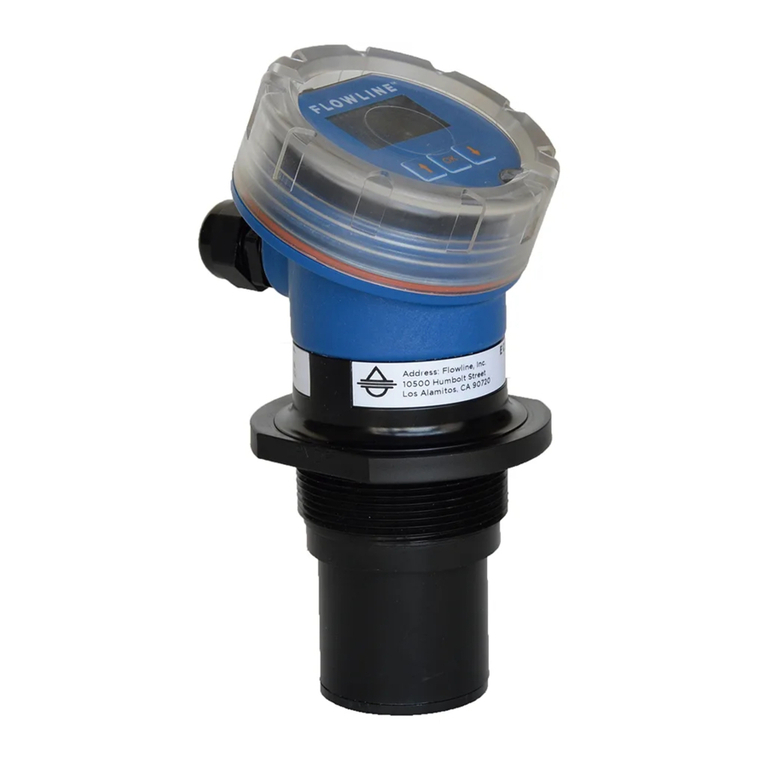
FlowLine
FlowLine EchoPod UG06 Series quick start
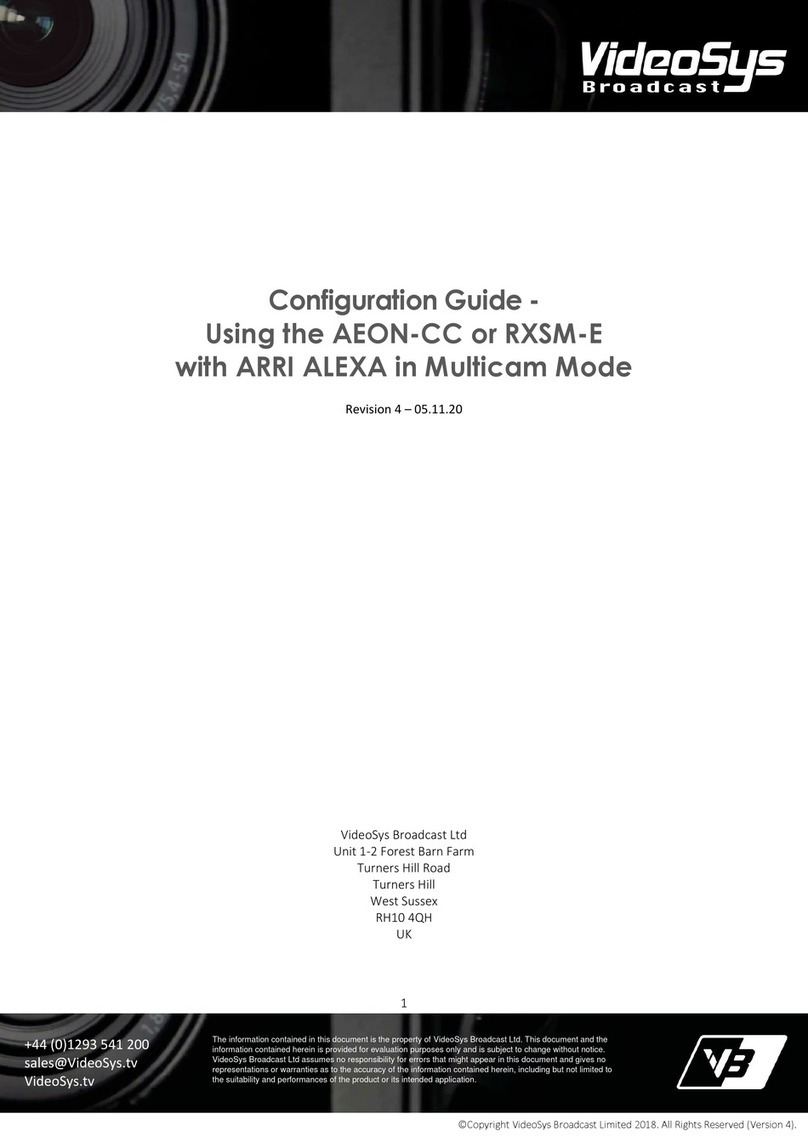
VideoSys
VideoSys AEON-CC Configuration guide

Shure
Shure AXIENT AXT100 manual
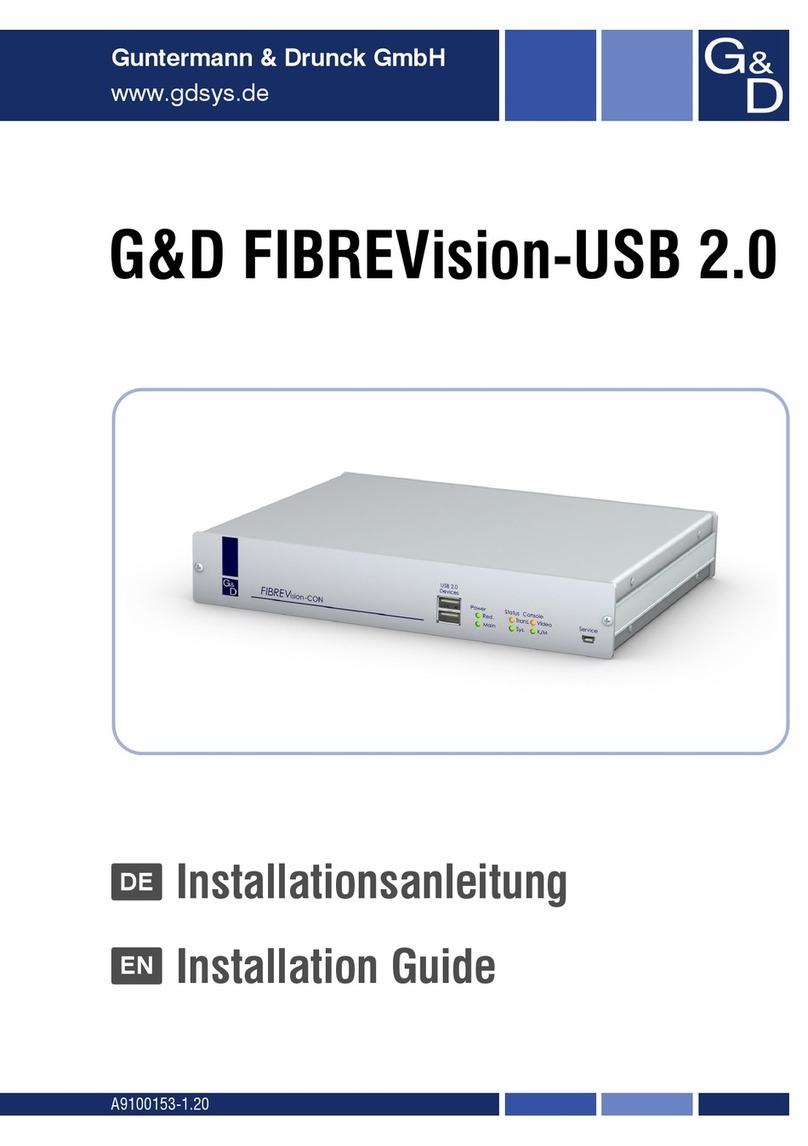
Guntermann & Drunck
Guntermann & Drunck FIBREVision-USB 2.0 installation guide
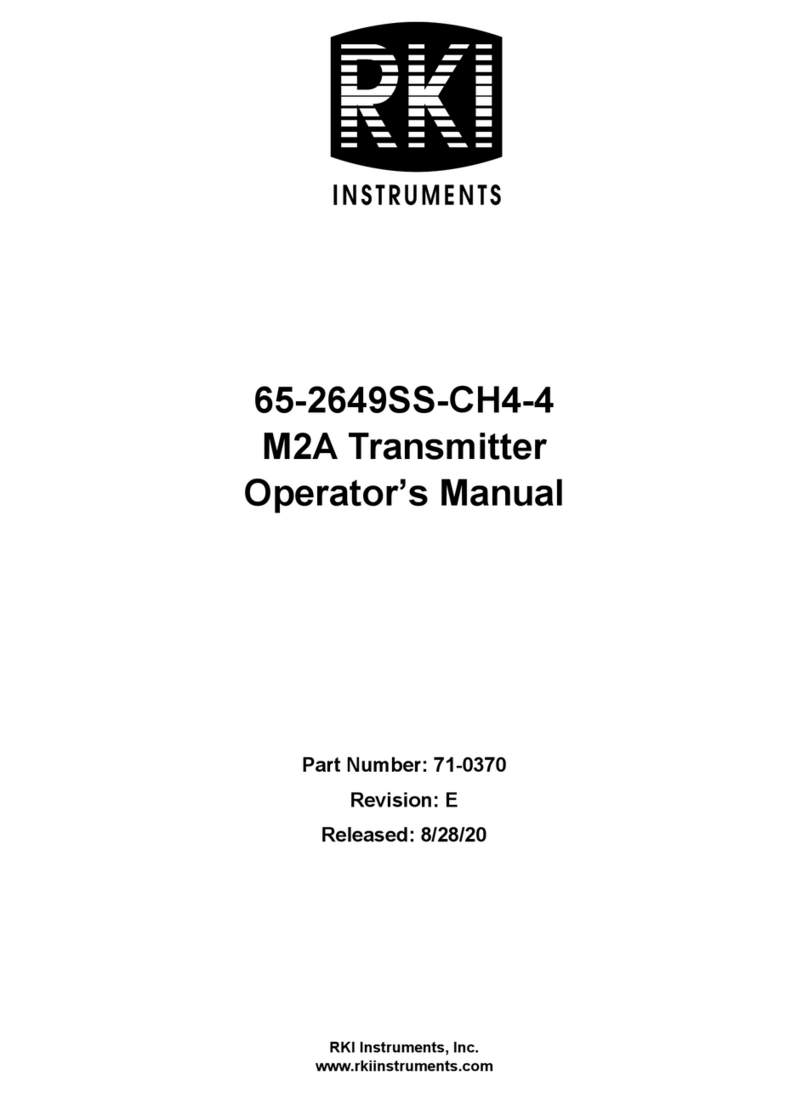
RKI Instruments
RKI Instruments 65-2649SS-CH4-4 Operator's manual
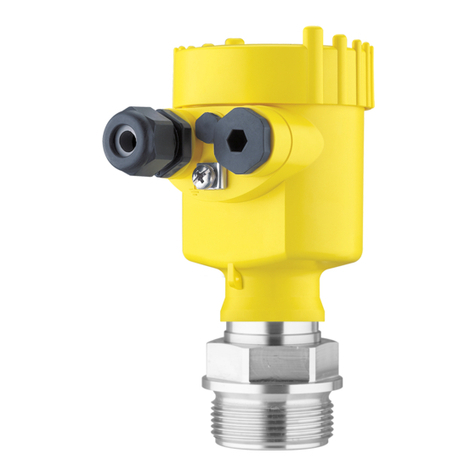
Vega
Vega VEGABAR 82 operating instructions
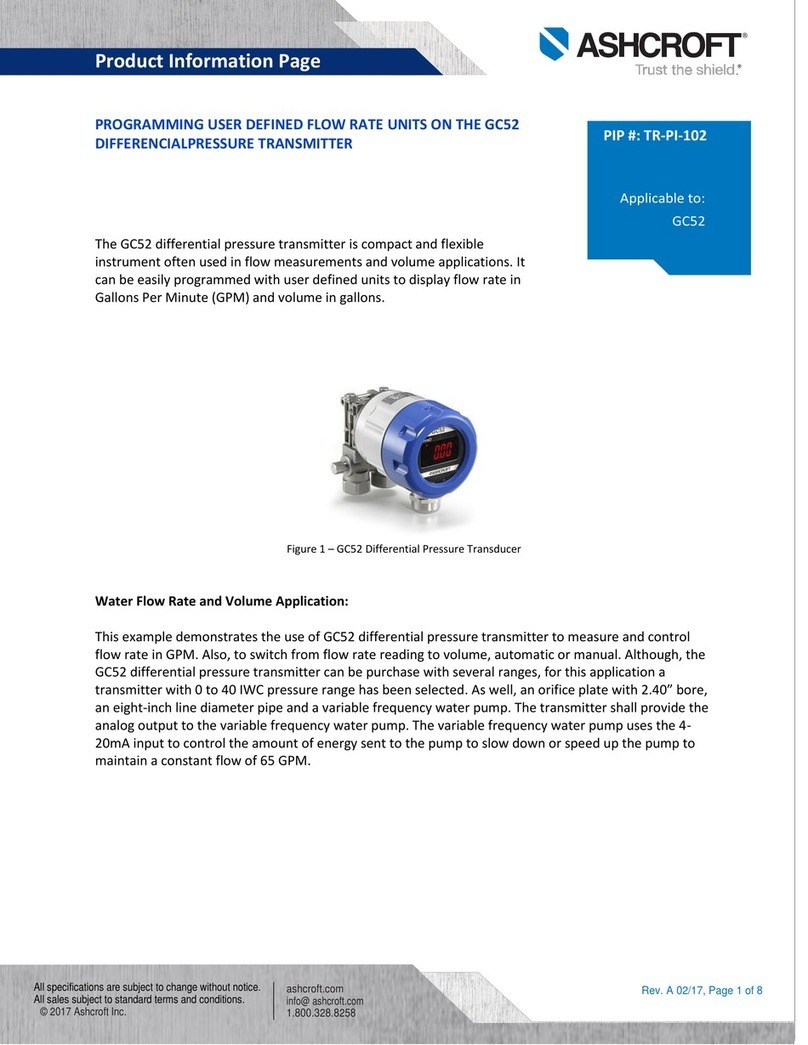
Ashcroft
Ashcroft GC52 Product Information Page

ARTEX AIRCRAFT SUPPLIES
ARTEX AIRCRAFT SUPPLIES ME406 ELT Description, operation, installation and maintenance manual
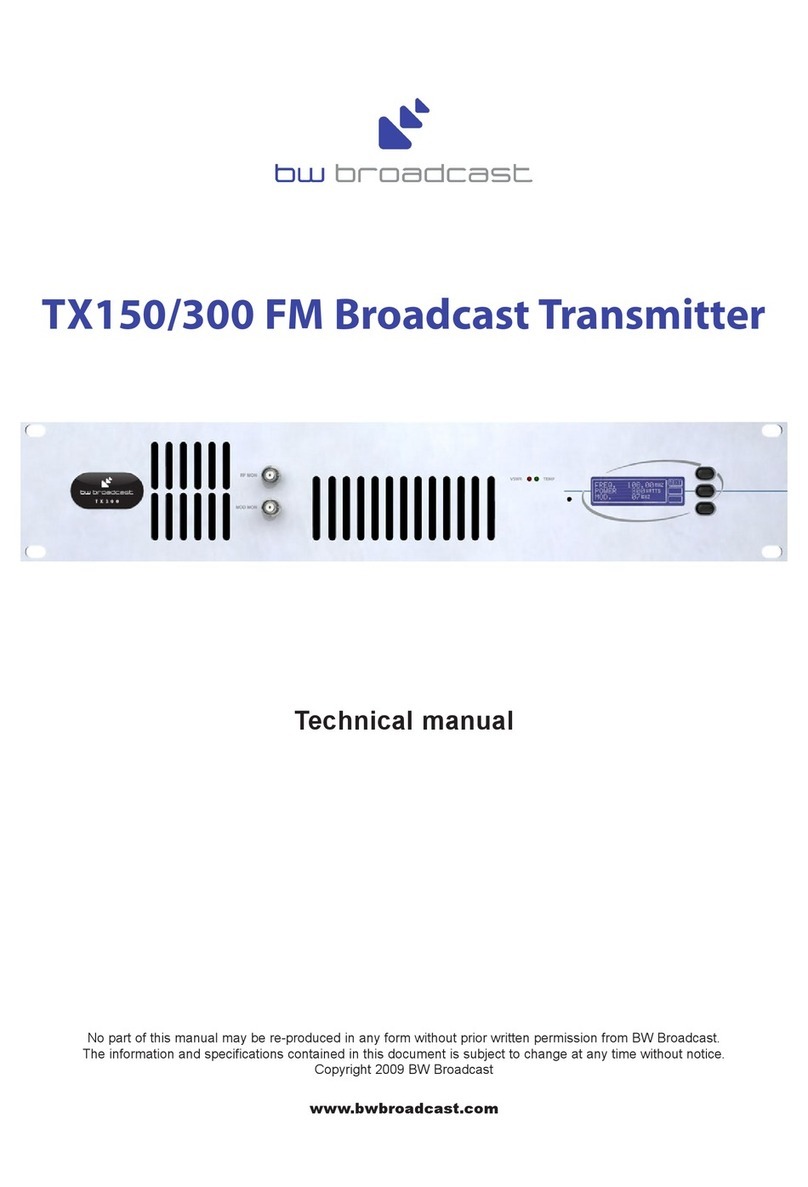
BW Broadcast
BW Broadcast TX150 Technical manual
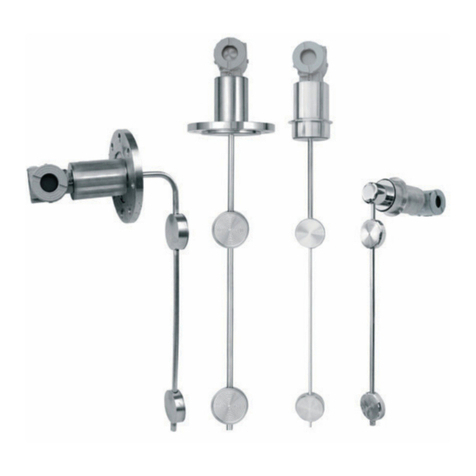
SMAR
SMAR DT302 Owner's operation and maintenance manual

